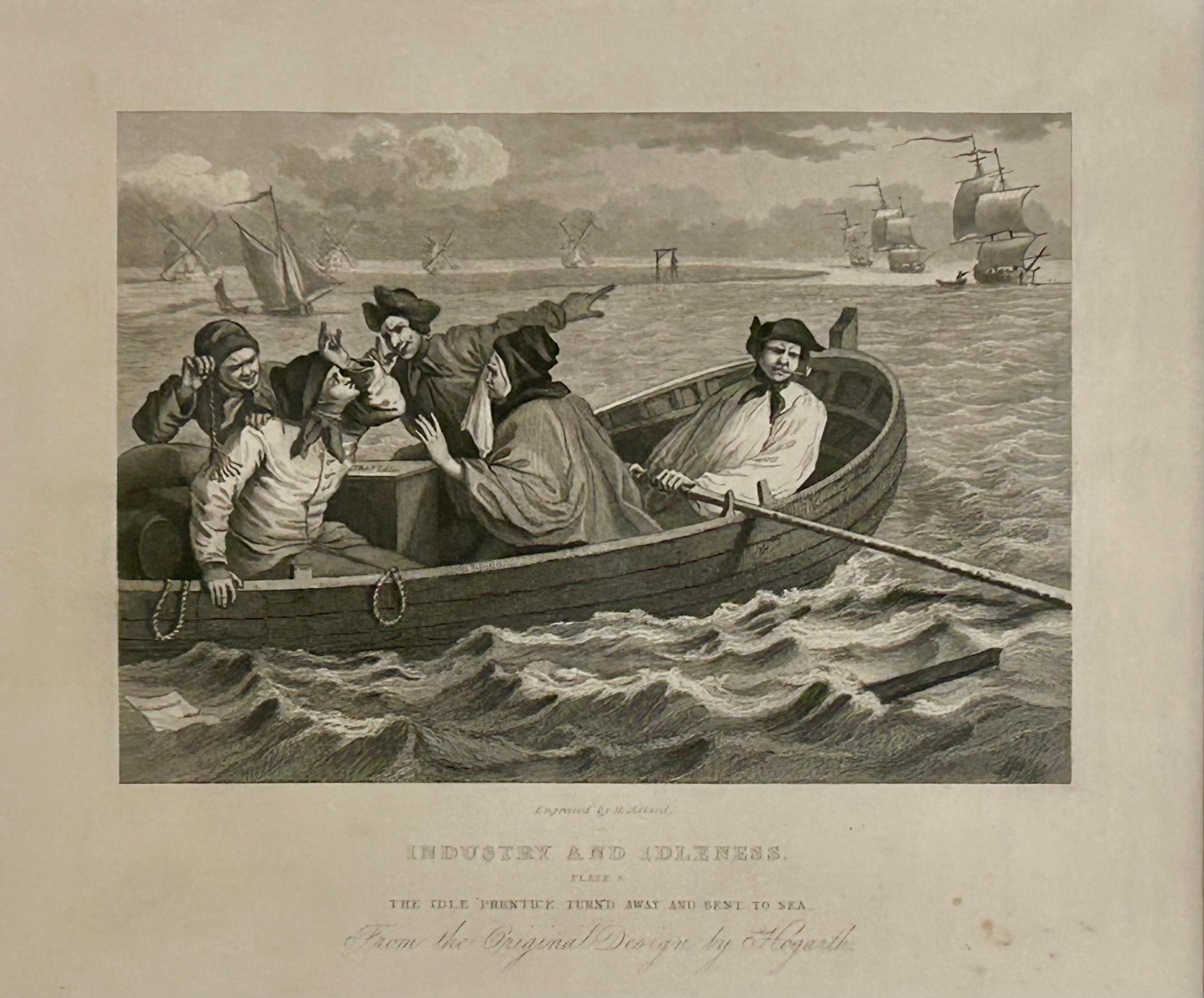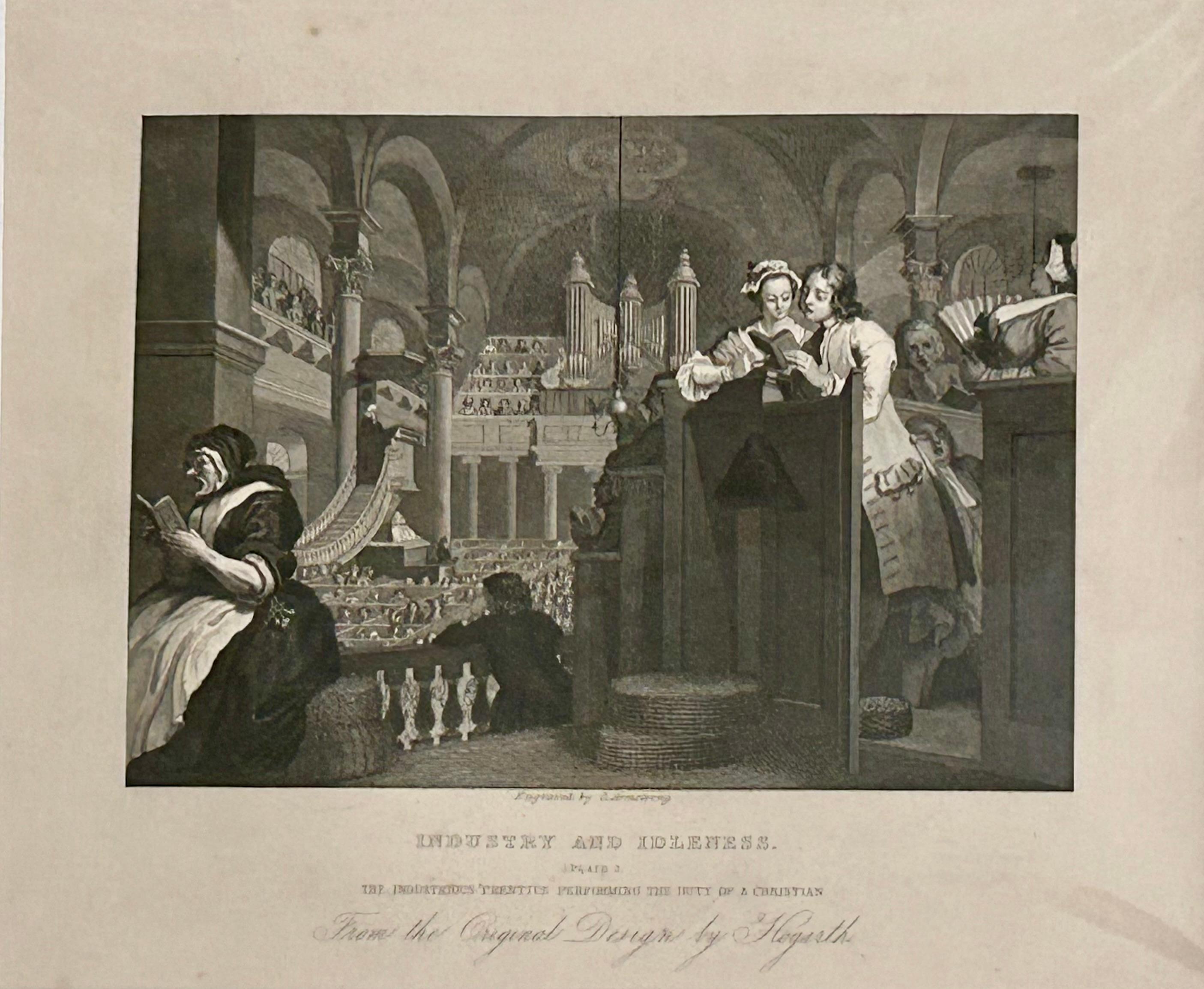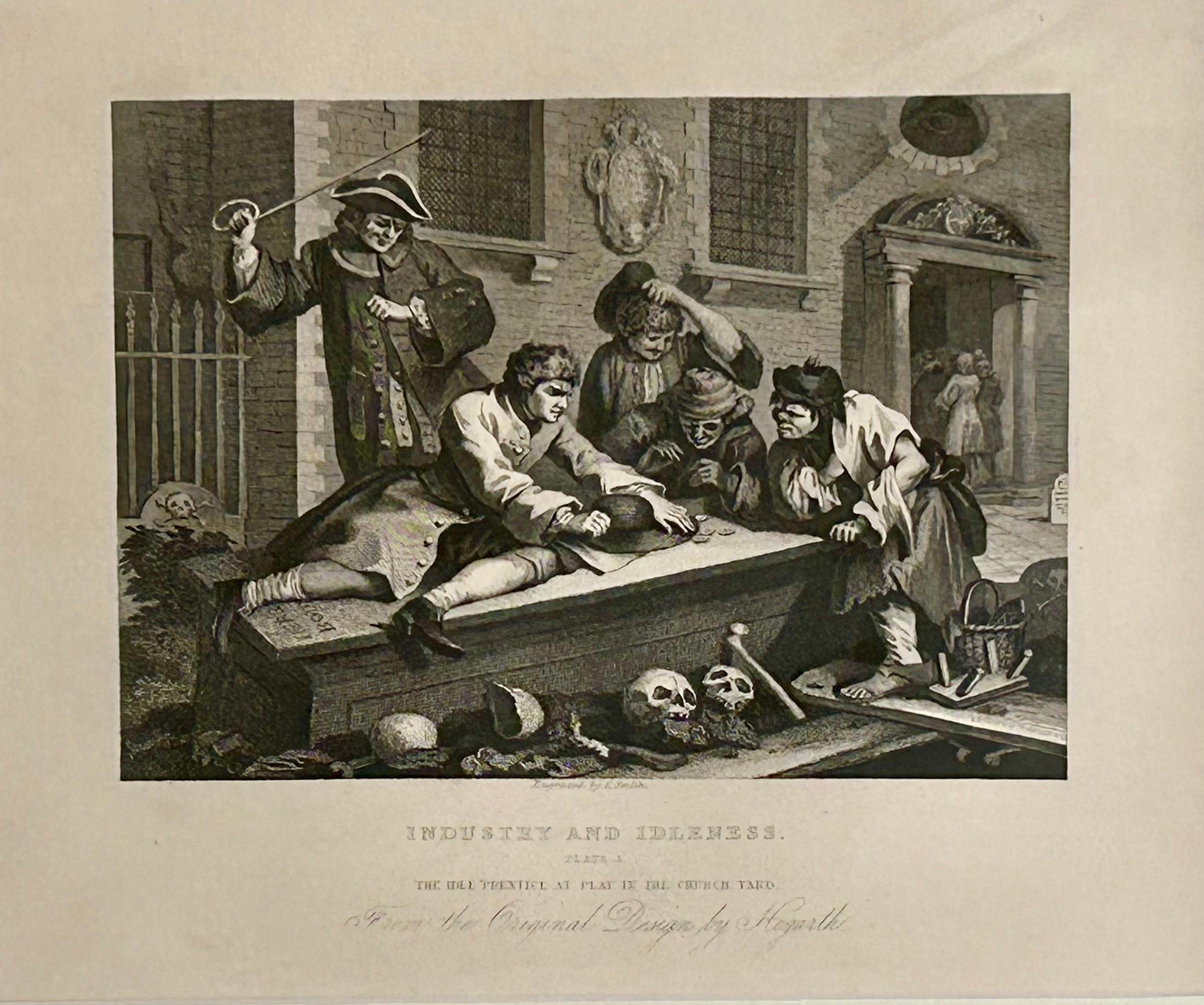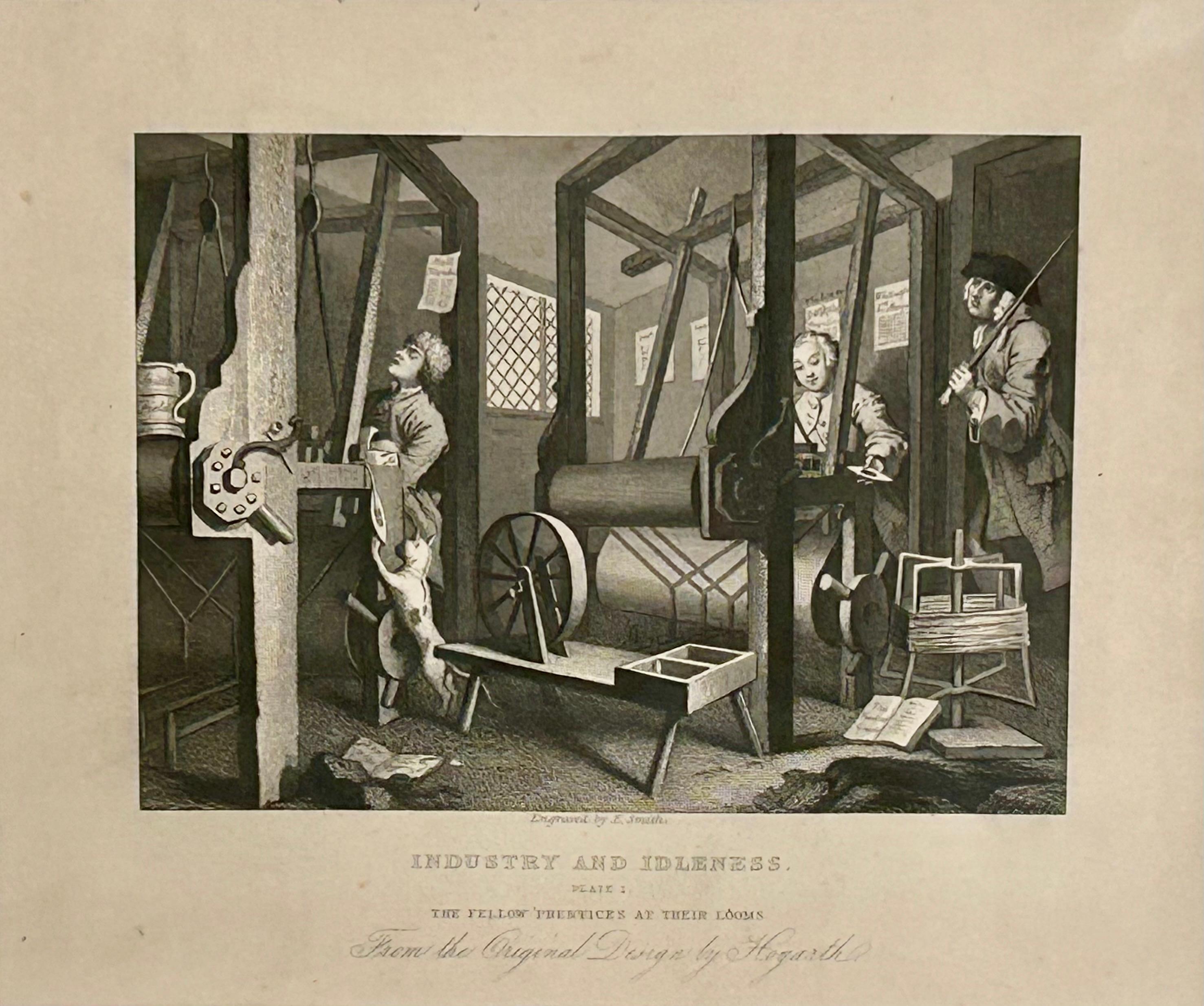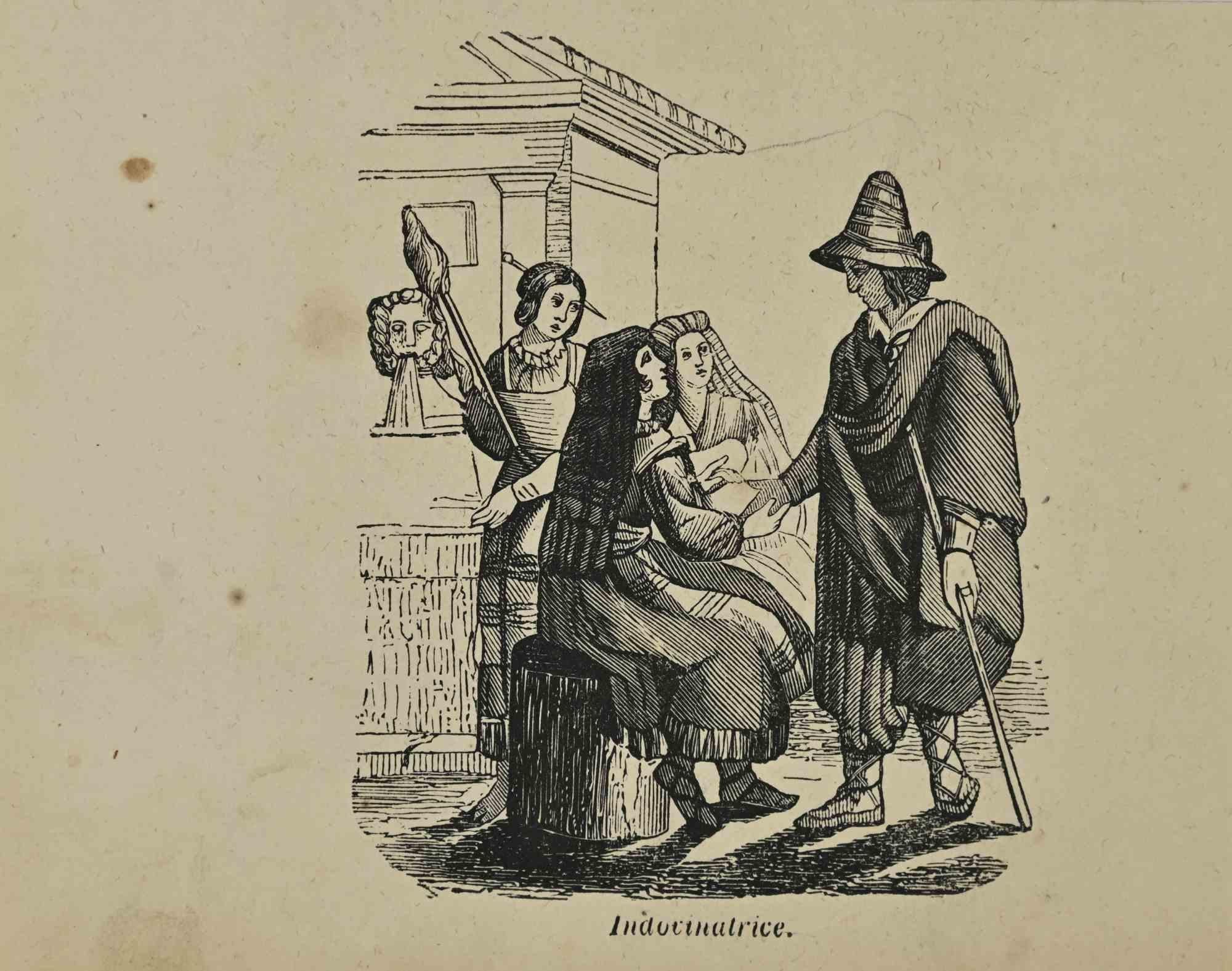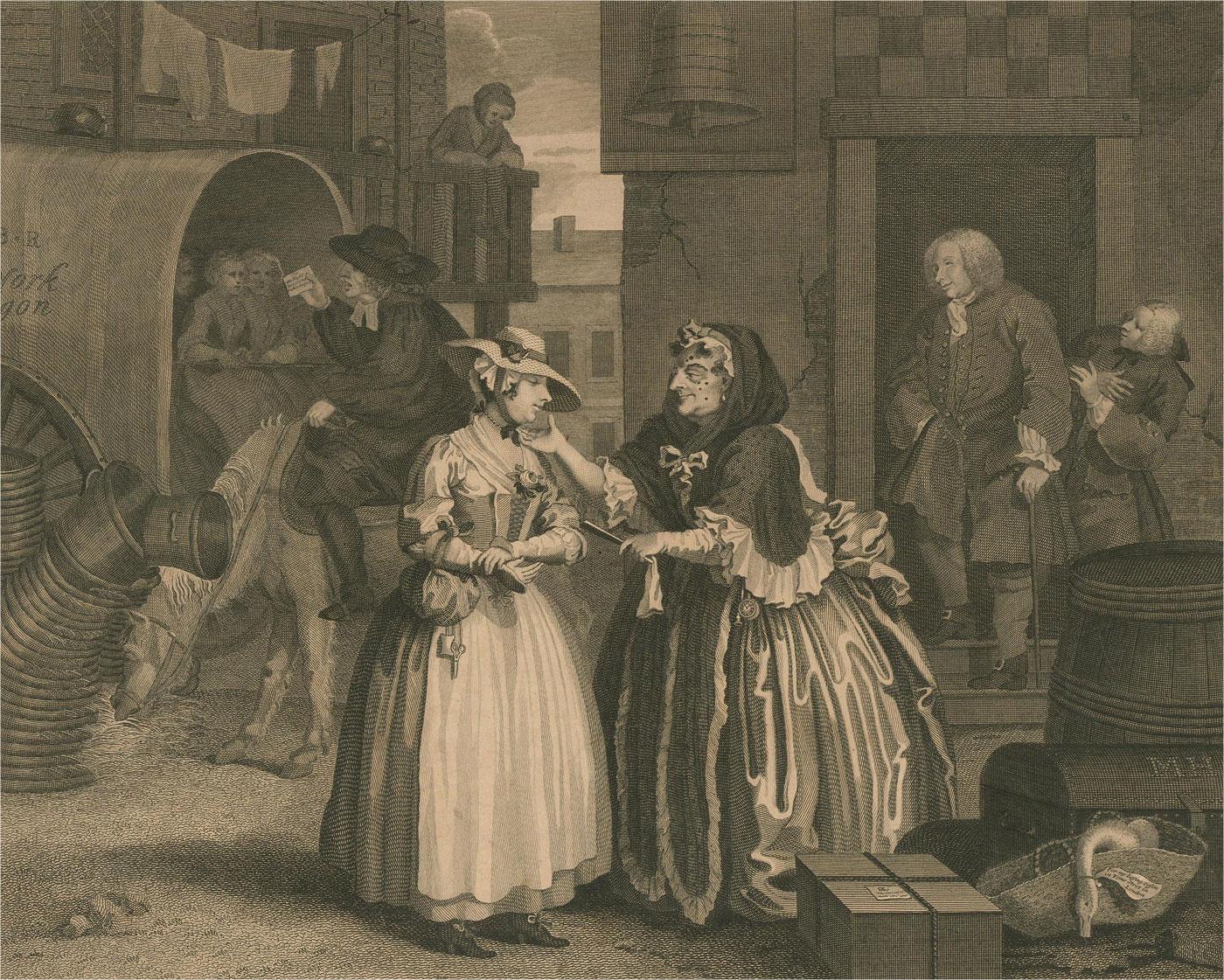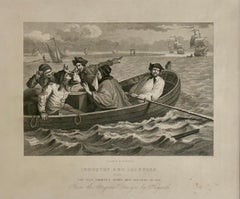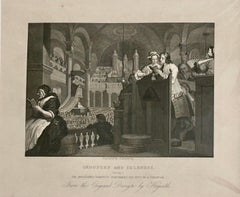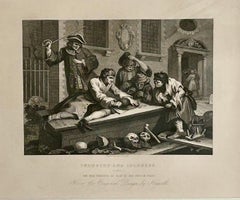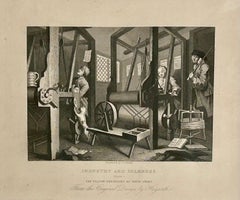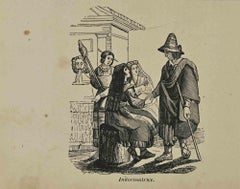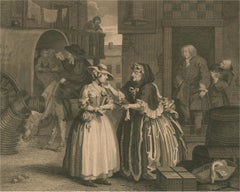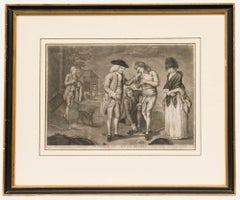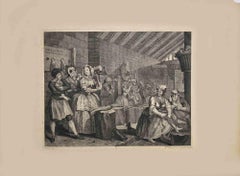Items Similar to Industry and Idleness Plate 7: The Idle 'Prentice Returned From Sea
Want more images or videos?
Request additional images or videos from the seller
1 of 3
Industry and Idleness Plate 7: The Idle 'Prentice Returned From Sea1830
1830
$181.74
$227.1720% Off
£136
£17020% Off
€157.76
€197.2120% Off
CA$256.30
CA$320.3720% Off
A$281.59
A$351.9920% Off
CHF 147.16
CHF 183.9520% Off
MX$3,358.17
MX$4,197.7120% Off
NOK 1,863.44
NOK 2,329.3020% Off
SEK 1,735.95
SEK 2,169.9420% Off
DKK 1,178.89
DKK 1,473.6120% Off
About the Item
William Hogarth was an English painter and engraver, the outstanding British artist of his period. During his childhood, his father, a schoolteacher, was imprisoned for debt, and this early experience of the seamy side of life left a deep mark on Hogarth (much of his output is concerned with the contrast between success and failure, and he depicted prisons in several works). He trained as an engraver of silver plate and by 1720 had set up his own business in London, doing various kinds of commercial work. In his spare time he studied painting, first at the St Martin's Lane Academy and later under Sir James Thornhill, whose daughter he married in 1729. By the early 1730s he had achieved some success as a painter of conversation pieces and at about the same time he invented the idea of using a sequence of anecdotal pictures ‘similar to representations on the stage’ to point a moral and satirize social abuses.
From a set of 12 original engravings illustrating Industry and Idleness, after the drawings by William Hogarth, printed in 1833. The engravers are F Jordan, E Smith, C Armstrong, S Davenport, H Adlard, W H Worthington, H Fernell, A Duncan and F F Walker. The engravings, which are in excellent condition, mounted and ready to frame
Read moreText source: The Oxford Dictionary of Art and Artists (Oxford University Press)
Engraved from the original by Wm Hogarth
Minor foxing
About the Seller
5.0
Gold Seller
Premium sellers maintaining a 4.3+ rating and 24-hour response times
Established in 2021
1stDibs seller since 2021
38 sales on 1stDibs
- ShippingRetrieving quote...Shipping from: Bournemouth, United Kingdom
- Return Policy
More From This Seller
View AllIndustry and Idleness Plate 5: The Idle 'Prentice Turn'd Away & Sent to Sea
By William Hogarth
Located in Bournemouth, Dorset
William Hogarth was an English painter and engraver, the outstanding British artist of his period. During his childhood, his father, a schoolteacher, was imprisoned for debt, and this early experience of the seamy side of life left a deep mark on Hogarth (much of his output is concerned with the contrast between success and failure, and he depicted prisons in several works). He trained as an engraver of silver plate and by 1720 had set up his own business in London, doing various kinds of commercial work. In his spare time he studied painting, first at the St Martin's Lane Academy and later under Sir James Thornhill, whose daughter he married in 1729. By the early 1730s he had achieved some success as a painter of conversation pieces and at about the same time he invented the idea of using a sequence of anecdotal pictures ‘similar to representations on the stage’ to point a moral and satirize social abuses.
From a set of 12 original engravings illustrating Industry and Idleness, after the drawings by William Hogarth, printed in 1833. The engravers are F Jordan, E Smith, C Armstrong, S Davenport, H Adlard, W H Worthington, H Fernell, A Duncan and F F Walker. The engravings, which are in excellent condition, would be mounted and ready to frame
Edward Smith (fl. 1823-49)
The landscape, figure, and portrait engraver Edward Smith may have been a native of Edinburgh but appears to have worked mostly in London. His earliest recorded plates...
Category
1830s Figurative Prints
Materials
Engraving
$181 Sale Price
20% Off
Industry and Idleness Plate 2: The Industrious 'Prentice Performing: Duty
By William Hogarth
Located in Bournemouth, Dorset
William Hogarth was an English painter and engraver, the outstanding British artist of his period. During his childhood, his father, a schoolteacher, was imprisoned for debt, and this early experience of the seamy side of life left a deep mark on Hogarth (much of his output is concerned with the contrast between success and failure, and he depicted prisons in several works). He trained as an engraver of silver plate and by 1720 had set up his own business in London, doing various kinds of commercial work. In his spare time he studied painting, first at the St Martin's Lane Academy and later under Sir James Thornhill, whose daughter he married in 1729. By the early 1730s he had achieved some success as a painter of conversation pieces and at about the same time he invented the idea of using a sequence of anecdotal pictures ‘similar to representations on the stage’ to point a moral and satirize social abuses.
A set of 12 original engravings illustrating Industry and Idleness, after the drawings by William Hogarth, printed in 1833. The engravers are F Jordan, E Smith, C Armstrong, S Davenport, H Adlard, W H Worthington, H Fernell, A Duncan and F F Walker. The engravings, which are in excellent condition, would be mounted (matted) and ready to frame
Edward Smith (fl. 1823-49)
The landscape, figure, and portrait engraver Edward Smith may have been a native of Edinburgh but appears to have worked mostly in London. His earliest recorded plates...
Category
1830s Figurative Prints
Materials
Engraving
$181 Sale Price
20% Off
Industry and Idleness Plate 3: The Idle 'Prentice at Play In The Church Yard
By William Hogarth
Located in Bournemouth, Dorset
William Hogarth was an English painter and engraver, the outstanding British artist of his period. During his childhood, his father, a schoolteacher, was imprisoned for debt, and this early experience of the seamy side of life left a deep mark on Hogarth (much of his output is concerned with the contrast between success and failure, and he depicted prisons in several works). He trained as an engraver of silver plate and by 1720 had set up his own business in London, doing various kinds of commercial work. In his spare time he studied painting, first at the St Martin's Lane Academy and later under Sir James Thornhill, whose daughter he married in 1729. By the early 1730s he had achieved some success as a painter of conversation pieces and at about the same time he invented the idea of using a sequence of anecdotal pictures ‘similar to representations on the stage’ to point a moral and satirize social abuses.
A set of 12 original engravings illustrating Industry and Idleness, after the drawings by William Hogarth, printed in 1833. The engravers are F Jordan, E Smith, C Armstrong, S Davenport, H Adlard, W H Worthington, H Fernell, A Duncan and F F Walker. The engravings, which are in excellent condition, would be mounted (matted) and ready to frame
Edward Smith (fl. 1823-49)
The landscape, figure, and portrait engraver Edward Smith may have been a native of Edinburgh but appears to have worked mostly in London. His earliest recorded plates...
Category
1830s Figurative Prints
Materials
Engraving
$181 Sale Price
20% Off
Industry and Idleness Plate 1: The Fellow 'Prentices at their Looms
By William Hogarth
Located in Bournemouth, Dorset
William Hogarth was an English painter and engraver, the outstanding British artist of his period. During his childhood, his father, a schoolteacher, was imprisoned for debt, and this early experience of the seamy side of life left a deep mark on Hogarth (much of his output is concerned with the contrast between success and failure, and he depicted prisons in several works). He trained as an engraver of silver plate and by 1720 had set up his own business in London, doing various kinds of commercial work. In his spare time he studied painting, first at the St Martin's Lane Academy and later under Sir James Thornhill, whose daughter he married in 1729. By the early 1730s he had achieved some success as a painter of conversation pieces and at about the same time he invented the idea of using a sequence of anecdotal pictures ‘similar to representations on the stage’ to point a moral and satirize social abuses.
A set of 12 original engravings illustrating Industry and Idleness, after the drawings by William Hogarth, printed in 1833. The engravers are F Jordan, E Smith, C Armstrong, S Davenport, H Adlard, W H Worthington, H Fernell, A Duncan and F F Walker. The engravings, which are in excellent condition, would be mounted (matted) and ready to frame
Edward Smith (fl. 1823-49)
The landscape, figure, and portrait engraver Edward Smith may have been a native of Edinburgh but appears to have worked mostly in London. His earliest recorded plates...
Category
1830s Figurative Prints
Materials
Engraving
$181 Sale Price
20% Off
Whoever Makes A Design Without the knowledge of Perspective
By William Hogarth
Located in Bournemouth, Dorset
William Hogarth was an English painter and engraver, the outstanding British artist of his period. During his childhood, his father, a schoolteacher, was imprisoned for debt, and th...
Category
1830s Figurative Prints
Materials
Engraving
$181 Sale Price
20% Off
Thomas Hudson - Remarkable for his Misfortunes
Located in Bournemouth, Dorset
Thomas Hudson, Remarkable for his Misfortunes
Stipple engraving by R. Cooper, 1821.
Date: 1 July 1821
Thomas Hudson lost his fortune in the South Sea Bubble after he had "ventured ...
Category
19th Century Figurative Prints
Materials
Engraving
$101 Sale Price
20% Off
You May Also Like
Uses and Customs - Guesser - Lithograph - 1862
Located in Roma, IT
Uses and Customs - Guesser is a lithograph on paper realized in 1862.
The artwork belongs to the Suite Uses and customs of all the peoples of the universe: " History of the governme...
Category
1860s Modern Figurative Prints
Materials
Lithograph
T. Cook after Hogarth - Six Early 19th Century Engravings, A Harlot's Progress
Located in Corsham, GB
The complete set of six engravings by Thomas Cook (1744-1818) after William Hogarth's (1697-1764) 'A Harlot's Progress', first a series of six paintings (1...
Category
19th Century Figurative Prints
Materials
Engraving
After Carington Bowles - 18th Century Engraving, The Prodigal Son Returns
Located in Corsham, GB
A charming engraving depicting the parable of the Prodigal Son in the Bible, found in Luke 15:11-32, after the original painting by Carington Bowles. Inscribed in plate. Presented in...
Category
Early 18th Century Figurative Prints
Materials
Engraving
A Harlot's Progress - Etching after William Hogarth - 1732
By William Hogarth
Located in Roma, IT
A Harlot's Progress is an etching print realized after William Hogarth in 1732
Signature on the plate on the lower right.
Good conditions, with some foxing.
A Harlot's Progress" i...
Category
1730s Surrealist Figurative Prints
Materials
Etching
The Pig Killers, by David Deuchar after Ostade
By Adriaen van Ostade
Located in Middletown, NY
Deuchar, David (after van Ostade). Les paysans tuant un porc.
Edinburgh: c1800.
Etching on thin cream laid paper, 4 11/16 x 4 11/16 inches (117 x 117 mm), narrow margins. Horizontal edge tear extending approximately 1-inch into the image area at the center left sheet edge. Skinning at the bottom-center sheet edge, verso, and adhesive residue at the top two corners, verso. Etched by David Deuchar after van Ostade, from A Collection of Etchings After the Most Eminent Masters of the Dutch and Flemish Schools particularly Rembrandt, Ostade, Cornelius Bega and Van Vliet, Edinburgh: 22 December, 1803.
"The pig killers is one of van Ostade’s most striking, both for its circular format and unusual lighting. Pictorial representations of pig slaughtering were known in medieval book illumination where they were incorporated into depictions of activities relating to the month of November or December. In this intimate, nocturnal scene, illuminated by torchlight, van Ostade combines coarse, barnyard realism with tender observation as a peasant family gathers round to witness the slaughter of a pig, which presumably will feed the large family during the long winter months. As the eldest son kneels on the animal, the farmer’s wife collects the blood in her long handled pan...
Category
19th Century Old Masters Figurative Prints
Materials
Handmade Paper, Laid Paper, Etching
Uses and Customs - Antique Painting - Lithograph - 1862
Located in Roma, IT
Uses and Customs - Antique Painting is a lithograph on paper realized in 1862.
The artwork belongs to the Suite Uses and customs of all the peoples of the universe: " History of the...
Category
1860s Modern Figurative Prints
Materials
Lithograph
More Ways To Browse
Camille Pissarro Signed
Carlos Merida Silkscreens
Carlos Schwabe
Chagall Coq
Chagall Moses Tablets
Chagall Offset Lithographs
Chagall Paradis
Charles Bragg Signed Prints
Dali Art Of Love
Dali Bird
Dali Don Quixote
Dali Dragon
Dali Le Cavalier
Dali Lithograph Bullfighter
Dali Signed Lithograph Numbered
Dali Virgil
Damien Hirst Gold
David Hockney Diver
